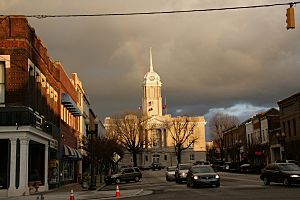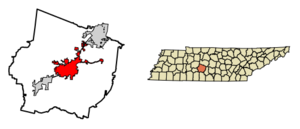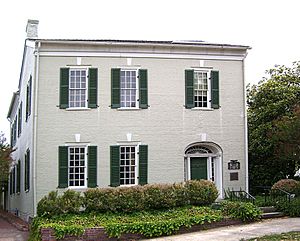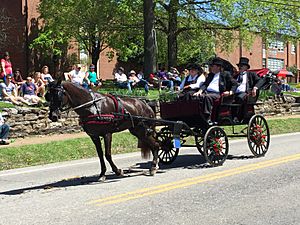Columbia, Tennessee facts for kids
Quick facts for kids
Columbia, Tennessee
|
|||
|---|---|---|---|

Columbia, Tennessee courthouse square
|
|||
|
|||
| Nickname(s):
Muletown
|
|||
| Motto(s):
Something good around every corner.
|
|||

Location of Columbia in Maury County, Tennessee.
|
|||
| Country | United States | ||
| State | Tennessee | ||
| County | Maury | ||
| Area | |||
| • Total | 33.79 sq mi (87.52 km2) | ||
| • Land | 33.77 sq mi (87.45 km2) | ||
| • Water | 0.03 sq mi (0.07 km2) | ||
| Elevation | 643 ft (196 m) | ||
| Population
(2020)
|
|||
| • Total | 41,690 | ||
| • Density | 1,234.71/sq mi (476.72/km2) | ||
| Time zone | UTC-6 (Central (CST)) | ||
| • Summer (DST) | UTC-5 (CDT) | ||
| ZIP Codes |
38401-38402
|
||
| Area code(s) | 931 | ||
| FIPS code | 47-16540 | ||
| GNIS feature ID | 1269483 | ||
Columbia is a city in Tennessee, and it's the main city of Maury County. This means it's the "county seat," where the local government offices are. In 2020, about 41,690 people lived here. Columbia is also part of the larger Nashville metropolitan area.
Columbia is known as the "mule capital of the world." Every April, the city celebrates Mule Day, a special event dedicated to mules. Maury County, where Columbia is located, is also famous for its many beautiful old homes built before the American Civil War. These homes are called "antebellum" houses. Columbia is also home to one of the only two remaining houses of James K. Polk, who was the 11th President of the United States. The other house is the White House!
Contents
History of Columbia

Columbia was founded in 1808, a year after Maury County was created. The first part of the town was built on the south side of the Duck River. Columbia officially became a city in 1817. For many years before the Civil War, Maury County was one of the richest counties in Tennessee. This was because of its large farms, which grew crops like tobacco and hemp. They also raised high-quality animals, including racehorses. Many enslaved people were forced to work on these farms.
After the Civil War, laws were passed in Tennessee that made it harder for African Americans to vote. This caused problems for many years in Columbia and Maury County.
During World War II, the city grew because of phosphate mining and the chemical industry, which helped the war effort. By 1940, over 10,000 people lived in Columbia. After the war, there were disagreements between white and Black workers at chemical plants. Black soldiers who had fought in the war wanted to be treated fairly when they returned home. This led to more efforts for civil rights in the 1950s and 1960s.
Today, Maury County is a popular place for tourists who want to learn about history. You can visit the James K. Polk Ancestral Home, the Columbia Athenaeum, and enjoy Mule Day. There are also many old plantation homes nearby.
Columbia is also home to Columbia State Community College, which was Tennessee's first two-year college. It opened in 1966, and President Lyndon B. Johnson even visited for its dedication in 1967.
Columbia's 1946 Event
On February 25, 1946, a difficult event happened in Columbia. It was called "the Columbia Race Riot" by the news. This event was seen as the first major racial conflict in the United States after World War II.
Geography of Columbia
Columbia is located at 35°36′54″N 87°2′40″W. It sits along the Duck River, which is the longest river that flows entirely within Tennessee. The Duck River is very special because it has more than 50 types of freshwater mussels and 151 types of fish. This makes it the most diverse river in North America! The river is also important to many Native American tribes.
The city covers about 29.6 square miles (76.7 square kilometers) of land. Columbia is about 637 feet (194 meters) above sea level.
Columbia's Population
| Historical population | |||
|---|---|---|---|
| Census | Pop. | %± | |
| 1850 | 2,977 | — | |
| 1860 | 4,069 | 36.7% | |
| 1870 | 2,550 | −37.3% | |
| 1880 | 3,400 | 33.3% | |
| 1890 | 5,370 | 57.9% | |
| 1900 | 6,052 | 12.7% | |
| 1910 | 5,754 | −4.9% | |
| 1920 | 5,526 | −4.0% | |
| 1930 | 7,882 | 42.6% | |
| 1940 | 10,579 | 34.2% | |
| 1950 | 10,911 | 3.1% | |
| 1960 | 17,624 | 61.5% | |
| 1970 | 21,471 | 21.8% | |
| 1980 | 26,571 | 23.8% | |
| 1990 | 28,583 | 7.6% | |
| 2000 | 33,055 | 15.6% | |
| 2010 | 34,681 | 4.9% | |
| 2020 | 41,690 | 20.2% | |
| 2023 (est.) | 47,448 | 36.8% | |
| Sources: | |||
2020 Census Information
| Race | Number | Percentage |
|---|---|---|
| White (non-Hispanic) | 26,962 | 64.67% |
| Black or African American (non-Hispanic) | 7,659 | 18.37% |
| Native American | 108 | 0.26% |
| Asian | 430 | 1.03% |
| Pacific Islander | 19 | 0.05% |
| Other/Mixed | 2,065 | 4.95% |
| Hispanic or Latino | 4,447 | 10.67% |
As of the 2020 United States census, Columbia had 41,690 people living in the city. There were 15,070 households and 9,855 families.
Education in Columbia
Students in Columbia attend schools run by Maury County Public Schools. There are also private schools like Agathos Classical School, Zion Christian Academy, and Columbia Academy. For higher education, the main campus of Columbia State Community College is in the city. This college serves nine counties in southern Middle Tennessee.
Famous People from Columbia
- James Edwin Ruthven Carpenter, Jr., architect
- Lynnette Cole, Miss Tennessee USA 2000, Miss USA 2000
- Andrew Frierson, opera singer
- Cecil Gant, blues musician
- Lyman T. Johnson, civil rights leader
- Jim Kelly, professional football player
- Red Lucas, professional baseball player
- Coo Coo Marlin, auto racer
- Steadman Marlin, auto racer
- Sterling Marlin, auto racer, won the Daytona 500 twice (1994 and 1995)
- Shaq Mason, NFL offensive guard and Super Bowl champion
- Fran McKee, first female line officer to be a rear admiral in the U.S. Navy
- Irvin C. Miller, pioneering Black actor
- Lindsey Nelson, radio and television sportscaster
- David Phelps, Christian vocalist
- James K. Polk, Governor, Congressman, Speaker of the U.S. House of Representatives and 11th President of the United States
- Shane Profitt, country music singer
- Sandra Seaton, playwright and librettist
- Natalie Stovall, country music singer
- Cowboy Troy, country music singer
- Dan Uggla, professional baseball player
- William Van Landingham, former MLB pitcher
- Mary Jane Watkins, dentist and actress
- Ben West, former Nashville mayor and supporter of civil rights movement, architect
- John Harlan Willis, United States Navy sailor, received the Medal of Honor for his actions in Battle of Iwo Jima during World War II
- Merrill Moore, American poet
- Samuel R. Watkins, Confederate Civil war soldier and author
See also
 In Spanish: Columbia (Tennessee) para niños
In Spanish: Columbia (Tennessee) para niños





